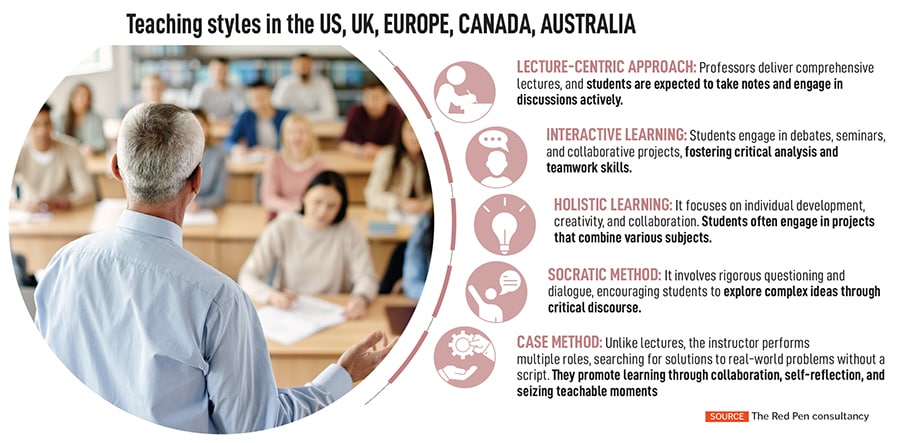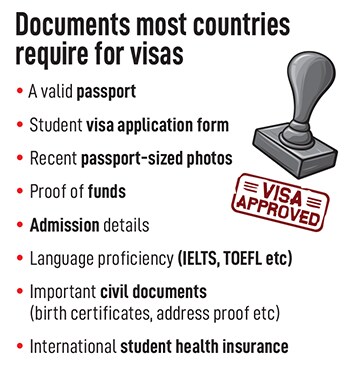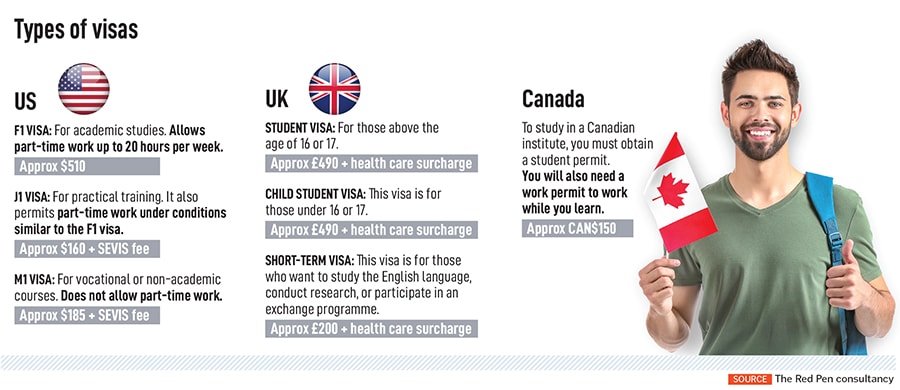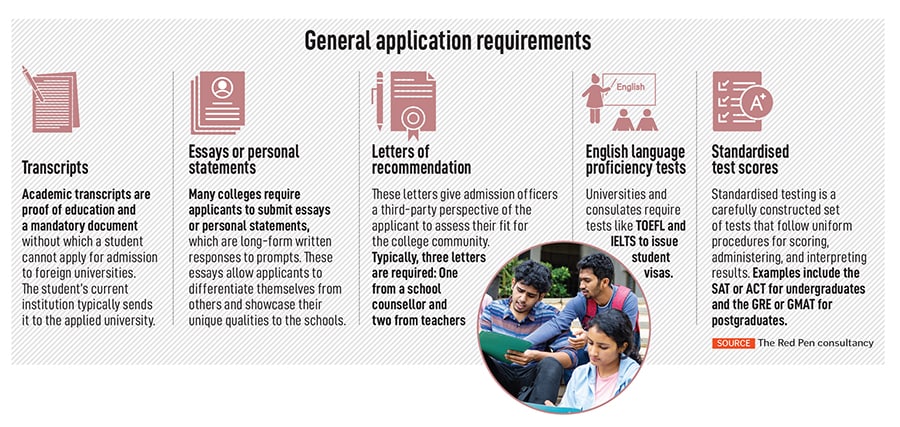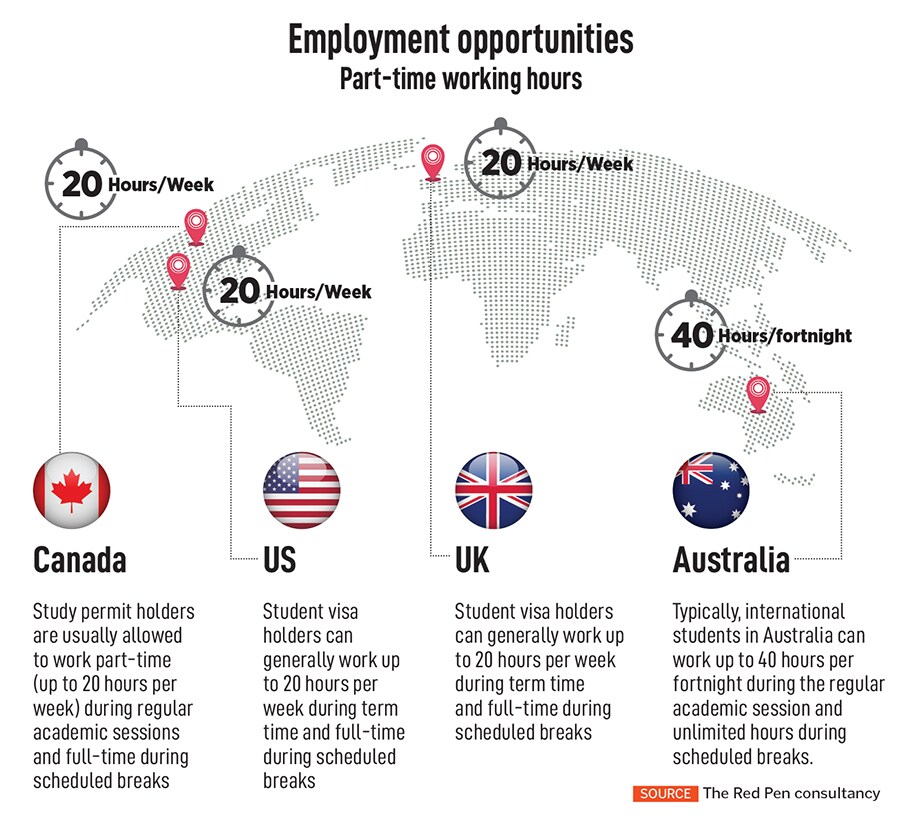Going abroad to study is a significant decision, and navigating its complexities can be daunting, given the many factors to consider, such as choosing the right destination, understanding visa requirements, cultural adjustments, and more. Therefore, it requires planning and a lot of clarity in the applicant’s mind.
Take Jahnvi Sampat’s case, for instance. The 18-year-old was sure about wanting to study abroad. She was also sure about pursuing her studies in the US because of the flexibility in choosing courses and the number of options offered by the universities there. So, she started working towards it when she was in Class 9.
“While you’re not applying in Class 9, you’re starting to build your profile because everything from Classes 9 to 12 counts towards your application," says Sampat.
“Start thinking about extracurricular activities. Most universities don’t look at the breadth, but the depth you go to for each activity. Have great accomplishments for whatever you’re doing."
Therefore, she ensured she played a sport, and a musical instrument, and pursued a hobby. Also, don’t underestimate the power of summer internships and schools, she says. “If you start slowly working from Class 9, it creates a really big impact," says Sampat.
With the help of The Red Pen, an education consultancy, she applied to about 14 universities in the US and has received acceptance from the University of Virginia, the University of Notre Dame, William & Mary, and the University of Richmond for a double major in English and economics. She’s waiting for more responses before zeroing in on one. “Your entire application will present a story for the major you want to do. It should be a reflection of what you’re doing," she adds.
While these students wait to see what their new life has to offer, they’re also anxious about being away from home and cultural adjustments. “I’m not worried about the language, but the academics and professors will be different. That’s the part I’m fearing a bit," says Tanna.
To ease the process of deciding and applying, here’s a comprehensive guide on everything students and their parents need to know before embarking on this journey, with help from three education consultants, Karan Gupta, The Red Pen and Learner Aid.
1. Choosing a destination:
The Red Pen: Once students have determined which course they want to study, they should assess factors such as the course modules, programme structure, and duration to understand if it meets their academic needs. They should also explore destinations renowned for the chosen course. For example, the US provides numerous opportunities for science and engineering, while France or Switzerland may be preferable for hospitality.
Karan Gupta: Other important points to consider would be the global rankings of the university, its accreditation, faculty reputation, and available scholarships.
Learner Aid: Keep alumni success and international recognition of the course in mind before locking in on a university.
2. Academic considerations:
The methods of teaching, grading systems, and curricula vary widely across cultures and countries.
A. Teaching styles:
The Red Pen: While Asian countries such as India and China emphasise rote learning, the US, UK, Europe, Canada, and Australia promote critical thinking and problem-solving skills (see box on teaching styles).
![]()
B. Grading:
The Red Pen: Grade Point average (GPA) is one of the most popular grading systems in the world and is used in many countries at various levels of study. Understanding the GPA system of the country is crucial. India uses a 10-point GPA system, while many other countries use a 4.0 grading scale. In the US, GPA is calculated using the grades for each completed coursework. This means, students must achieve consistently high grades to maintain a strong GPA. For students receiving funding, this is crucial as scholarship programmes may not provide financial support to those who fall below a certain GPA.
In the UK, overall scores are calculated at the end of the course rather than being based on the student’s average throughout the course.
Most European countries use the European Credit Transfer and Accumulation System (ECTS) to measure academic achievements across different higher education systems. This makes qualifications easily comparable between countries, although different countries still have their own grading systems.
C. Curriculum:
The Red Pen: Curricula vary across countries and universities. The UK focuses on subject-specific programmes and requires the completion of specific subjects in high school. For instance, students who want to pursue an economics degree need to study maths in Class 12. UK-based universities also do not allow minors or second majors however, some offer combined degrees like economics and management. Undergraduate applicants are also expected to declare their major when they apply and they can’t change it later.
In contrast, the US offers a multidisciplinary approach and a flexible credit system. Students can pursue diverse subjects, along with a major, such as music and literature alongside a biology major. Post-declaration, students are allowed to change majors as well.
3. Application requirements:
The Red Pen: Each country follows its application requirements and process. For example, the US has centralised platforms such as the Common App Platform, Coalition Platform, and UC Application Platform. Students also have the choice to individually apply to universities. However, in the UK, all applicants must use the UCAS platform. (See box)
![]()
4. Understanding visa processes:
The Red Pen: Obtaining a student visa has become fairly easy with the option to apply online. Through the immigration portal of the desired country, applicants can effortlessly create a profile and access all necessary forms in a centralised system. Alternatively, they can visit visa centres set up by embassies.
There are two types of international visas—short-term and long-term. Short-term visas are for students studying courses for less than three months, while long-term or graduate visas are for courses lasting more than three months. Additionally, visas can vary based on whether students choose to study or seek employment after completing their course. (See box)
To prevent potential complications, students should consider applying for their visa at least three to four months before their course begins. They should start the visa application after getting admission in their preferred college, as it may require significant time.
Learner aid: Students must convey their educational goals, the rationale for selecting a particular university, and how the chosen course aligns with their career ambitions. Exhibiting financial stability by presenting detailed bank records, proof of funding such as loan approvals or scholarship endorsements to demonstrate the student’s capability to support their education and stay is helpful. Visa officials also assess students’ ties to their home country to gauge their likelihood of returning post-study. Present compelling evidence of your connections at home, robust financial planning, and sincerity in your educational pursuit, often demonstrated through a well-crafted statement of purpose or during an interview.
![]()
5. Financial planning
Karan Gupta: Planning to study abroad involves expenses in two major areas: Tuition fees and living costs. Other costs include food, transportation, health services, visas, and travel tickets. Students can consider scholarships and funding options for financial aid. Other factors to keep in mind are exchange rates, banking options in the destination country, and means to manage finances abroad. Compare tuition fees across institutions. Investigate part-time work opportunities, and loan options for international students.
The Red Pen: The expenses of studying abroad differ by country. In the UK, international students can expect to pay between £15,000 (₹15 lakh) and £65,000 (₹68 lakh) annually for tuition fees, whereas the cost of living can vary between £10,000 (₹10 lakh) and £18,000 (₹18 lakh). In the US, depending on whether the university is private or public, the annual tuition fee can vary between $30,000 (₹25 lakh) and $67,000 (₹55 lakh), while the living and miscellaneous costs can range between $13,500 (₹11 lakh) and $24,000 (₹20 lakh).
If finances are a concern, explore opportunities for financial aid and scholarships. While colleges in the US allow international students to apply for financial aid, their chances and options are limited in the UK. Alternatively, students can also consider applying to public universities in countries like Germany, where tuition is free for both domestic and international students, offering a cost-effective option for pursuing an education abroad.
6. Cultural differences
The Red Pen: One of the most common challenges international students face is the language barrier. Adjusting to different rules, attitudes, and behaviours can be perplexing initially. Fortunately, there are many strategies they can use to improve their language skills. For instance, seeking out language exchange partners, joining conversation clubs, and watching local TV shows and films. Taking language classes before arriving is also helpful.
Homesickness is also a natural part of many students’ experiences of studying abroad. Immersing in local activities and making new friends can help students feel at home. Joining clubs or organisations related to one’s interests can be a great way to meet like-minded individuals and make new connections
Learner aid: Utilise university resources like international student offices, cultural orientation sessions, and language support services. Orientation week serves as an introduction to the academic and social landscape, offering newcomers a chance to familiarise themselves with campus facilities, meet peers, and understand university life.
Tip: Once in the country, participate in local customs and traditions. Whether you try new foods, attend a cultural festival, watch local TV, or learn a traditional dance, embracing these experiences can help you feel more connected to your new environment.
7. Health and safety
The Red Pen: While most popular study-abroad destinations are generally safe, the risks of studying abroad are similar to those in one’s home country. However, taking precautionary measures to safeguard well-being and health is advisable. For instance, enrolling in travel and health insurance programmes, which include mental health services. Universities also have health and well-being departments. It’s important to acquaint oneself with cultural norms, local laws, and attitudes toward gender identification and sexuality in the host country. Students are advised to carry personal information and essential contact numbers in hard copy and electronically on their mobile devices.
The Center for Global Education provides a printable sample emergency contact card.
Students with specific health needs should obtain written documentation detailing their health issues, prescribed medications, and recommended care plans, accurately translated into the local language.
Tip: Once in the new country, students should familiarise themselves with the local health care system, emergency procedures, and safety protocols.
8. Legal and Documentation Requirements:
Learner aid: Organise and verify all necessary legal documents, including academic records, identification, and travel documents. Ensure compliance with all residency and academic regulations to maintain your student status. Proactively manage visa status to ensure uninterrupted legal residency, aligning with each nation’s distinct regulations and application timelines for visa extensions or modifications.
Karan Gupta: Ensure that passports are valid for the duration of the study period. Understand residency requirements, permits, and any necessary legal documentation for international students.
![]()
9. Housing and accommodation
The Red Pen: Finding suitable housing for international students can be challenging. Here are some of the acco₹mmodation options you may find:
A. On-campus accommodation
Living in university dormitories, also known as on-campus housing, are close to the campus, and come with built-in support from staff and other students. They’re often cheaper than renting. You can meet other students easily and join campus activities.
B. Purpose-Built Student Accommodations (PBSAs)
These residences, with modern facilities and campus proximity, offer an ideal alternative for students seeking convenience and comfort in their living arrangements.
C. Homestays
Students are accommodated with a local family in their home. It’s a great way to soak in the local culture and practice the language. Host families often provide meals and a supportive environment, but adjusting to their way of life might take some time.
D. Apartments
Sharing an apartment is usually a favourite choice among international students who want to live off-campus. But before booking one, consider its proximity to the university, neighbourhood safety, affordability, and additional expenses like utilities. Double-check amenities and the lease terms, and review previous tenants’ experiences. Ensure you have all the necessary documentation. To avoid scams, research properties, and landlords, refrain from wiring money, review lease agreements, see the property in person, and trust your instincts. Protecting yourself is crucial.
E. Hostels
Hostels are affordable and have shared living spaces. But, they might not be as private or comfy as apartments, and noise can be an issue.
Tip: Don’t forget the little things, like internet speed or laundry facilities. They might seem trivial, but they’re part of your everyday comfort.
![]()
10. Employment opportunities and internships
Learner aid: This is the most important factor for any student.
International students often have the opportunity to work part-time during their studies, typically limited to 20 hours per week during term time, with the possibility of full-time employment during holidays, subject to visa regulations. In the US, students on an F1 visa can apply for Optional Practical Training (OPT) to work in their field of study for up to 12 months after graduation, with extensions available for certain STEM fields. The UK offers a two-year post-study work visa under the Graduate Route, allowing students to seek employment or work experience after completing their studies. Australia’s post-study work visa allows graduates from Australian universities to work for 2-4 years, depending on their qualification level. In Canada, the Post-Graduation Work Permit Program (PGWPP) allows students who have completed a programme at a Canadian post-secondary institution to obtain an open work permit and gain valuable Canadian work experience. France offers a post-study work visa that permits non-EU students to stay and work for a year after graduation to seek employment related to their field of study. Other important points:
A. Current affairs and geopolitics:
Changes in political leadership can alter immigration policies, affecting crucial aspects such as student visas, residency options, and stay-back provisions. Recent events, such as the Russia-Ukraine conflict, highlight how political tensions can disrupt the lives of international students, leading to displacement and uncertainty. Therefore, students must stay informed about global politics and international developments.
B. International student population: Living and studying in a country with a different academic environment, language, and culture is challenging. Large numbers of international students indicate a more diverse student body. Approximately 10.5 lakh international students are studying in the US, 10.4 lakh in Canada, and 6.7 lakh in the UK.

